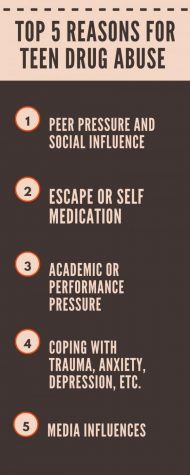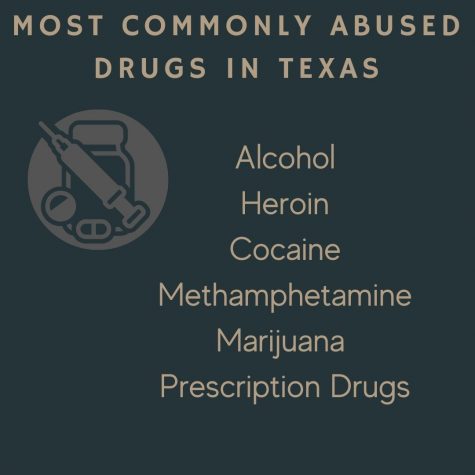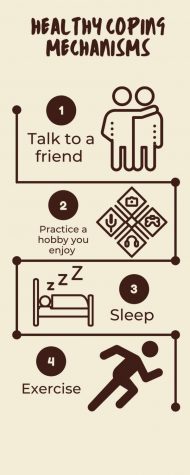Drug abuse puts student — and others — at risk
Officers spread awareness to save lives
A substance abuse infographic made by student council reminds students about the risks of drugs and alcohol. Campus police officer Darrell Terry encourages students to speak out against substance abuse. “If that person came in and said something, we like to be a mentor for that person, figure out what they’re struggling with and get them help,” Terry said. “We only want to be a help to students.”

Passion left.
Care stopped.
Separation from family and friends happened again.
This is the true story of what is occurring right now for one Prosper student — and maybe even more.
With teenagers subject to peer pressure, drug problems have circulated throughout schools in the U.S. Statistics show that teenagers are even more at risk to drug addiction than any other age group. Those battling addiction and substance abuse often struggle alone, and few talk about it.
A student that chose to stay anonymous struggled with substance use since their freshman year. In the midst of their addiction, they lost interest in their passions in and out of school.
“I realized my addiction was getting bad,” the student said. “I stopped caring about things I used to care a lot about.”
They attended a rehabilitation center to help cope with their substance abuse problem.
“It was bad for the first couple of days because of the detox,” they said. “But after that, I embraced it.”

The student said they felt more comfortable in the rehabilitation center as time went on.
“It became easier to talk about my trauma,” they said, “once I became comfortable getting to the root of my problem.”
Based on studies shown from Newport Academy, children and teens who use drugs are more likely to have a substance abuse disorder as adults.
“Say something. Don’t be quiet about substance abuse,” campus police officer Darrell Terry said. “Substance abuse is something that takes over if you don’t get help. It starts out small, but any substance that starts out small becomes a big thing.”
Terry works with Sergeant Christopher Reeves to serve the high school students’ safety needs, including helping them avoid a substance-abuse situation.
“Without awareness, students and young people are not going to realize the penalties or effects on their bodies. So, awareness is the base of it,” Reeves said. “You should start hearing about the effects of drugs from a very early age.”

In academics, students under stress from school have shown a tendency to lean toward substances. In Texas alone, more than 555,324 kilograms of marijuana has been seized, ranking the state as No. 1 for the total amount captured by law enforcement agencies.
A common myth is that drugs help cope with stress – whether it’s academic or personal, but statistics show this is not the case. According to studies, addictive drugs can cause the same amount of changes to a student’s brain as stress does. Long-term abuse of substances makes users more sensitive to everyday stress than non-users.
“Awareness is important because it saves lives,” Reeves said. “It saves lives and mends positive relationships between family and community.”
Your donation will support the student journalists of Prosper High School. Your contribution will allow us to purchase equipment and cover our annual website hosting costs.

Honors & Awards:
2 Lone Star Emmy awards for High School Fiction, 2023
4 Best Of Sno Publications, 2021-2023
3 Official Selections in All American High School Film Festival, 2021-2022
Vice President of the Junior Class 2021
Quill & Scroll 2021-present, Member
Winning Entry in Quill and Scroll 2021 International Writing Contest, Feature Writing, 2021
National Technical Honor Society 2020-present, Communications Officer
Student Council 2020-present, Member










